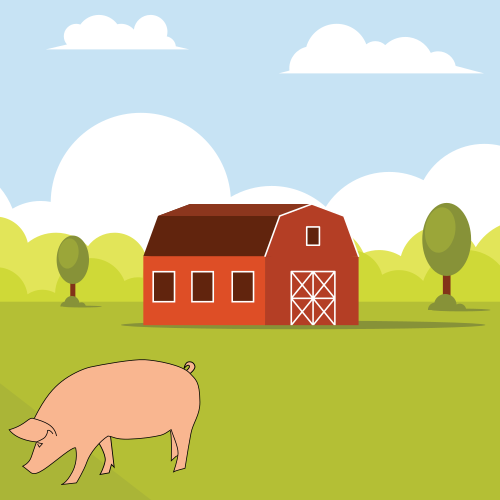Small
 SEGS Lab Research Projects: Biosecurity
SEGS Lab Research Projects: Biosecurity
Food security and economic security are vulnerable to the consequences of new, emerging, or trans-boundary animal diseases reaching the United States and spreading rapidly through food animal populations, triggering export market closures and raising concerns about food safety. Preparing for such a disaster is a complex challenge. Because of human resistance to preparing for something that is not part of one’s individual experience or the collective experience of one’s social network, developing and maintaining protocols and policies effective at preventing the spread of disease is difficult.
A Systems Approach to Securing the New England Milk Supply in the Event of a Foot-and-Mouth Disease Outbreak
Objectives include engaging dairy industry stakeholders in developing a regional biosecurity plan to mitigate the impacts of FMD, build a hybrid model of disease spread and control strategies using network information and use the model to test novel strategies and incentives, and visualize systemwide effects.
|
Status: On-going
Project lead: Julie Smith Team: Scott C. Merrill Funding provided by: USDA NIFA |
Predicting Livestock Disease Transmission Dynamics under Alternate Biosecurity Risk Management Interventions and Behavioral Responses of Livestock Producers
Transmission of foreign animal diseases, such as foot and mouth disease and African swine fever, could pose a significant risk to US livestock producers. Current approaches US animal health authorities use to manage this risk and the behavioral responses of livestock producers to these policies are not well understood in an integrative way. The overarching goal of this project is to better understand and predict the risk of foreign animal disease transmission among livestock herds in the US. We will test alternative interventions and alternative sequences of interventions, while determining the expected behavioral responses of livestock producers to these interventions. We will test multiple hypotheses with the goal of identifying interventions that improve the alignment of economic incentives, increase the effectiveness of risk communication, and enhance voluntary surveillance of foreign animal disease at minimal cost to taxpayers and livestock producers. Our three research objectives are the following: (1) We will design and test a novel Artificial Intelligence (AI) model to simulate transmission of two foreign animal diseases (foot and mouth disease and African swine fever) in the US livestock sector. (2) We will conduct surveys of livestock producers and implement online experimental games to calibrate the representation of human behavior in the AI model and test alternative policy configurations. (3) We will harness both survey and AI model data to identify combinations of risk management strategies and leverage points in livestock supply chain networks that minimize risk of spreading from livestock diseases.
|
Status: On-going Project lead: Prof. Asim Zia Funding provided by: National Institute of Food and Agriculture |
The Animal Disease Biosecurity Coordinated Agricultural Project (ADBCAP)
We are integrating social science, human decision-making, economic and animal health perspectives to enhance the prevention, recognition, control and recovery from any new, emerging or foreign animal disease or pest. With a multi-disciplinary team from land grant universities across the United States, our goal is to facilitate the development and adoption of national practices and policies to reduce the impact of pests and diseases in livestock animals, including dairy and beef cows, horses, pigs, sheep, goats, camelids (llamas and alpacas) and poultry.
|
|
Status: Completed Project lead: Project lead: Julie Smith Team: Scott C. Merrill, Asim Zia, Chris Koliba, Gabriela Bucini, Eric Clark, Trisha Shrum, Nick Cheney Funding provided by: USDA National Institute of Food and Agriculture Project Progress Reports: Year 1 Year 2 Year 3 Year 4 |
Secure Food Supply New England Style
Funded by the National Animal Disease Preparedness and Response Program (NADPRP), Secure Food Supply New England is a Vermont-led, New England-wide project that will build on previous projects to:
|
|
Status: On-going Project lead: Julie Smith Team: Scott C. Merrill, Robby Beattie, Juniper (June) Urbani, Jonas O'Mara, Eli Smith Funding provided by: NADPRP (Farm Bill funding through the USDA APHIS Veterinary Services (VS) National Animal Disease Preparedness and Response Program (NADPRP) under cooperative agreement AP21VSSP0000C008) |

National Pork Board Mapping Application Work
To develop a prototype mapping application for use by farmers or trained specialists (e.g., food animal veterinarians) for use in biosecurity management, planning, and preparation. The application would allow for easy, online placement of biosecurity features needed for each secure pork supply (SPS) map view, such as peripheral buffer areas and lines of separation, onto an aerial representation of the premises.
|
Status: Completed Project lead: Julie Smith Team: Scott C. Merrill, Eli Smith, Gian Cercena, Eric Clark Funding provided by: National Pork Board |